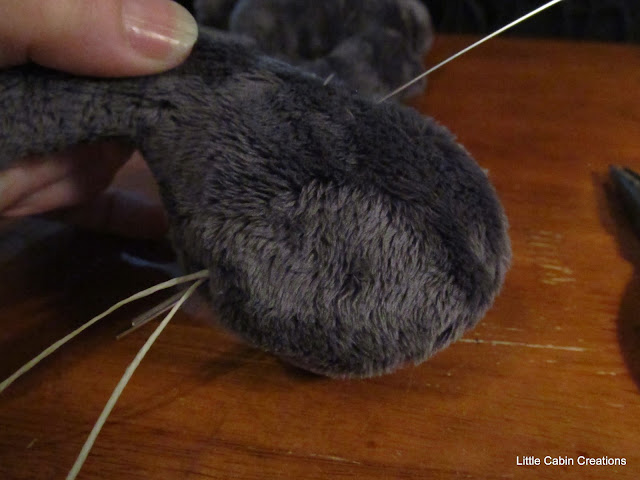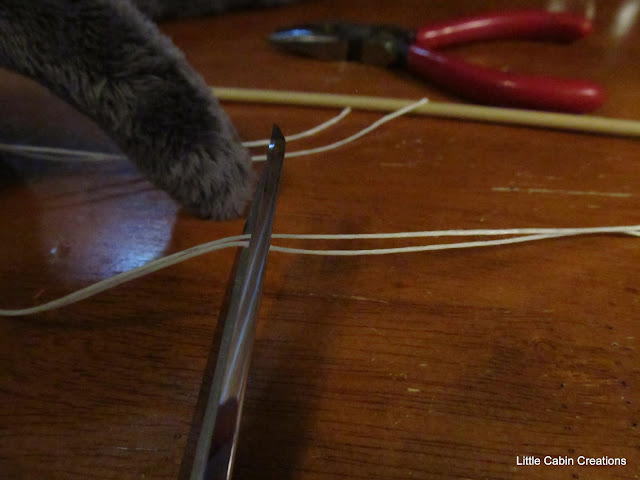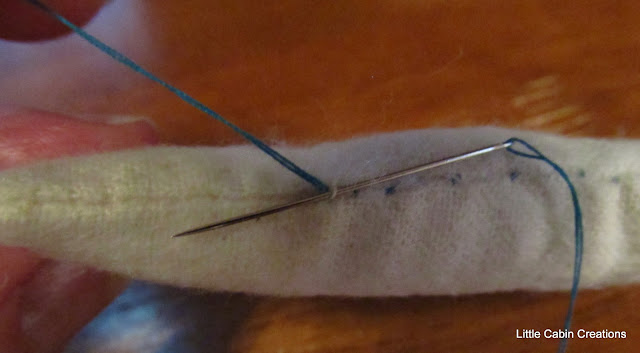Before I attach Penelope's head to her
body, I want to sew on her eyes.
just like the antique bears & animals.
I use a very long needle with a large eye and
a long length of heavy waxed cord that's doubled.
Any type of strong thread doubled will work.
Waxing your thread adds strength.

Mark where you want to place the eyes.
My marks are down in the fur.
Insert the needle at the bottom on the head,
just to the edge of the joint disc. Come out
where the mark is.

I enlarge this hole a bit with my sharp knitting
needle or wooden skewer, just enough
to allow the entire loop of the eye to go inside the head.
DON'T cut the fabric, gently spread the fibers.
If you want to change the placement of the eye, it's
easy to push the fibers back together and make
a different hole.
back into the hole.
Come out next to the entry point.
One eye in place.

Insert the same needle into the bottom of the
head on the other side of the disc joint &
come out where the second eye is marked.
Enlarge the hole. Put the eye on the end of the
needle and go back through the hole.

Come out next to the entry point.

Pull both threads, until you like the look of the eyes.
The eye on the left needs to be pulled in tighter.


Cut the long threads.

To hide your thread ends, re thread one double-thread,
insert into the bottom of the head. Come out
any place on the head.
Do this with the other doubled thread end.
I use my needle nose pliers to help pull the thick thread.
Attach the head to the body by finishing the joint
inside the body. (previous post)
I sew up the remaining seams of the body parts
with a ladder stitch.
Here is the ladder stitch done on a pretend
arm made out of flannel and bright blue
thread doubled , so you can easily
see how it's done.
I have marked the seam line in the photo below,
just for reference.
Start at one end. Insert the needle underneath the
fabric, along the seam line, close to where the prior
seam stitching ends.
Pull it through.
Cross over to the other side. Insert the needle
through the top of the fabric, on the seam line.
Come out about 1/4 inch away, on the seam line.
Pull the thread through, leaving a very loose stitch.
Cross over to the other side. Insert the needle on
the seam line, move the needle down the inside fold
of the seam. Come out about 1/4 inch away on the
seam line.

Cross over and repeat.
See how it looks like a ladder?
Continue this crossing over & moving down the
inside of the seam,

until you get to the end.
I use the eye end of a large needle to push the
stuffing and seam edges down and pull the fur
up, as I tighten each stitch. Start at the beginning.
Wrap a couple loops around the needle.
Pull the needle through.
Stick the needle back into the fabric next to the
knot, come out anywhere.
Pull tightly
& cut the thread.
Finished seam.
You can also tighten your stitches as you go.
When working with bulky fur, it seems to go
smoother for me if I do that last.
On Penelope's arm, the seam is virtually
invisible after I pick out the remaining fur that
was stuck in the seam.

Thank you ladies for your comments,
I'm glad you enjoy these lengthy silly
tutorials of mine, but hopefully they help your
doll or animal making a bit easier.















































































